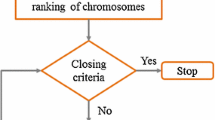Abstract
The traditional selection methods for the selection of sensor network node under high-speed mobile environment is randomness, which cannot effectively use the multiple attributes of nodes, resulting in the irregular distribution of cluster head of nodes, and high energy consumption. An optimal selection method for sensor network node under the high-speed mobile environment based on EERNFS and Naive Bayesian Networks is proposed. By using EERNFS algorithm within each network intercept / sleep cycle, the sensor network node is made processing under high-speed mobile environment, to ensure the stable local connectivity and consistent collaboration intercepts, and reduces energy consumption. Naive Bayes algorithm is used to make optimization of general Bayesian classification method, and set the parameters. In the two-dimensional area, several sensor nodes are randomly placed, and the known two-dimensional area is divided. A certain node is selected arbitrarily in different regions to constitute the original set of Naive Bayes algorithm, and compute the training results and thresholds in the Bayesian system of node set at this moment. On the basis of the threshold, the optimal selection of sensor network node is achieved. Simulation results show that the proposed method not only has higher node coverage, but also the operating efficiency and energy consumption are better than the genetic method.









Similar content being viewed by others
References
Bas CU, Ergen SC (2013) Ultra-wideband channel model for intra-vehicular wireless sensor networks beneath the chassis: from statistical model to simulations. IEEE 1(62):14–25
Bouabana A, Sourkounis C (2013) Analysis of a measurement system in respect to the dependency of the current sensor sampling rate and the inverter switching time. IEEE (39) 3877–3882
Chang C-C, Hsu T-E (2014) The study of micro-bridge structure PZT underwater ultrasonic sensors with Al sacrificial layer. IEEE 8(5):1–5
Cheng VW, Wang T-Y (2012) Performance analysis of distributed decision fusion using a multilevel censoring scheme in wireless sensor networks. IEEE 4(61):1610–1619
Cheymol G, Gusarov A, Gaillot S et al. (2013) Dimensional measurements under high radiation with optical fibre sensors based on white light interferometry - report on irradiation tests. IEEE (3):1–7
Choudhary H, Kumar A, Bahl R et al. (2013) Enhanced passive acoustic localization with an array of non-identical sensors using blind Gauss-Markov estimate. IEEE (8) 1–6
Clark DA (2010) Correction of electric and magnetic fields and gradients measured within and around an insulating sensor capsule in seawater. IEEE 10(9):1–9
Efros AA, Narasimhan SG (2009) Estimating natural illumination from a single outdoor image. ICCV 5(8):183–190
Gosiewski Z, Kulesza Z (2013) Virtual collocation of sensors and actuators for a flexible rotor supported by active magnetic bearings. IEEE 2(9):94–99
Kapoor NK, Majumdar S, Nandy B et al. (2012) Sensor allocation to multiple applications in shared wireless sensor networks. IEEE (31) 197–198
Kembhavi A, Harwood D, Davis LS (2009) Human detection using partial least squares analysis. ICCV 5(6):24–31
Kim Y, Sim J-Y, Kim C-S (2015) Spatiotemporal saliency detection for video sequences based on random walk with restart. TIP 5(11):2552–2564
Kumar D, Sarma H, Rai P et al (2014) Energy efficient communication protocol for wireless sensor networks with mobile node. IEEE (8) 1–6
Kumar AA, Sivalingam KM (2012) Target tracking in a WSN with directional sensors using electronic beam steering. IEEE (9) 1–10
Lee H, Kim B, Kwon Y et al. (2015) The comparison of RBS and TDP for the sensor networks synchronization. JIPS (8) 5–10
Levy R, Papin G, Le Traon O et al. (2014) A high resolution vibrating beam accelerometer working in nonlinear region for seismic ground sensor application. IEEE (8) 1–3
Li G, Yang D, Li R, Cai M, Li C, Wang L (2014) Mold flow analysis of molding process for a MEMS fingerprint sensor package. IEEE 2(15):1534–1538
Liu T, Wang G, Chan KL (2015) Video tracking using learned hierarchical features. TIP 3(2):1424–1435
Liu Z, Yang J (2009) Sparsity induced similarity measure for label propagation. ICCV 12(20):317–324
Meti SA, Sangam VG (2015) Biological sensor performance validation using fusion technique. IEEE (5) 1158–1163
Nowozin S (2009) On feature combination for multiclass object classification. ICCV 9(25):221–228
Obeid S, Dogaru T (2015) Improvement on printed circuit board inspection using injected AC current and GMR magnetic sensor. IEEE (25) 150–154
Rella MA, Galletti D, Maguer A, Stoner R, Molinari E (2011) Assessment of CTD and optical sensor calibration differences between standalone sensors and those mounted within an undersea glider. IEEE 6(8):1–8
Singh V (2009) An efficient algorithm for co-segmentation. ICCV 9(12):269–276
Author information
Authors and Affiliations
Corresponding author
Rights and permissions
About this article
Cite this article
Zhu, L., Jeong, H.Y. Research on an optimal selection method for sensor network node under high-speed mobile environment. Multimed Tools Appl 76, 19635–19647 (2017). https://doi.org/10.1007/s11042-015-3234-9
Received:
Revised:
Accepted:
Published:
Issue Date:
DOI: https://doi.org/10.1007/s11042-015-3234-9




